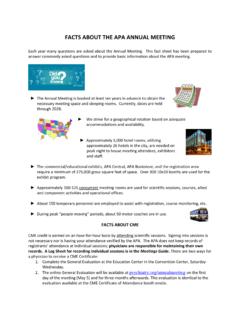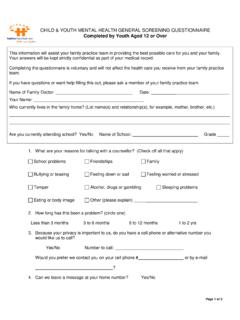Transcription of DSM-5 SELF-EXAM QUESTIONS - Psychiatric News: …
1 DSM-5 SELF-EXAM QUESTIONS Disruptive, Impulse Control, and Conduct DisordersThe chapter on disruptive, impulse control, and conduct disorders is new to DSM-5 . It combines disorders that were previously included among dis-orders usually first diagnosed in i n fa nc y, childhood, or adolescence (that is, opposi-tional defiant disorder; conduct disorder; other specified and unspecified disrup-tive, impulse-control, and conduct dis-orders) or impulse-control disorders not otherwise specified (that is., intermittent explosive disorder). These disorders are all characterized by problems in emo-tional and behavioral self -control. Of note, attention-deficit/hyperactivity disorder (ADHD) is frequently comorbid with the disorders in this chapter but is listed with neurodevelopmental disorders.
2 The crite-ria for oppositional defiant disorder (ODD) are largely unchanged from D S M - I V-T R . The criteria for conduct disorder are also largely unchanged from D S M - I V-T R. A descriptive-features specifier is added for individuals who meet full criteria for the disorder and who also present with limited prosocial emotions. The primary change in DSM-5 for intermittent explosive disorder is what type of aggressive outbursts should be considered: D S M - I V-T R required physi-cal aggression, whereas in DSM-5 verbal aggression and nondestructive/noninju-rious physical aggression also meet cri-teria. An important departure from past diagnostic manuals is that the substance-related and addictive-disorders chapter is expanded to include gambling disorder.
3 This reflects the increasing and consistent evidence that some behaviors, such as gam-bling, also activate the same reward system with effects similar to those of drugs of QUESTIONS below are from DSM-5 SELF-EXAM QUESTIONS : Test QUESTIONS for the Diagnostic Criteria, which may be preor-dered from American Psychiatric Publish-ing here. [ ] The answers and rationales are posted here. [ ] The book, available in February 2014, contains 500 QUESTIONS for all the categories of Psychiatric disorders and includes Section III. The ques-tions were developed under the leadership of Philip Muskin, , a professor of clinical psychiatry at Columbia University College of Physicians and Surgeons.
4 APA members may purchase the book at a Which of the following is new in DSM-5 for the diagnosis of ODD?a) Categorization of ODD symptomsb) Failure to resist an impulse, drive, or temptation to perform an act that is harmful to the person or to othersc) The individual feels an increasing sense of tension or arousal before the act, pleasure, gratification, or relief during the actd) The individual experiences a sense of relief from the urge after the acte) Premeditation of the actCorrect Answer: A. Categorization of ODD : DSM-5 has instituted a new categorization of ODD symptoms that groups together symptoms based on whether they have an emotional component (for example, angry, irritable, resentful), a behavioral ele-ment (for example, argumentative, defiant), or a spiteful/ vindictive aspect to them.
5 This classification structure is important because recent research suggests that the emotional symptoms are linked to the development of future mood and anxiety disorders and spite-ful and vindictive behaviors are predictive of conduct disorder and delinquent Which disorder is most commonly comorbid with ODD?a) ADHDb) Mood disorderc) Conduct disorderd) Bipolar disordere) Learning disordersCorrect Answer: A. ADHDR ationale: The most common disorder that coexists with ODD is (ADHD, with comorbidity rates reportedly reaching up to 39%. Other disorders that frequently occur with ODD include anxiety and depressive A 21-year-old male with history of oppositional defiant disorder presents with frequent impulsive behavioral outbursts that are grossly out of proportion to the stressor.
6 He reports that he is unable to control himself and worried that he might lose his job if this behavior continues. What is his most likely diagnosis?a) Bipolar disorderb) A DHDc) Intermittent explosive disorderd) Conduct disordere) Adjustment disorderCorrect Answer: C. Intermittent explo-sive disorderRationale: The diagnosis of intermittent explosive disorder can be made in older ado-lescents and young adults aged 18 or older in addition to the diagnosis of ADHD, opposi-tional defiant disorder, conduct disorder, or autistic spectrum disorder when recurrent impulsive aggressive outbursts warrant inde-pendent clinical attention. PN





